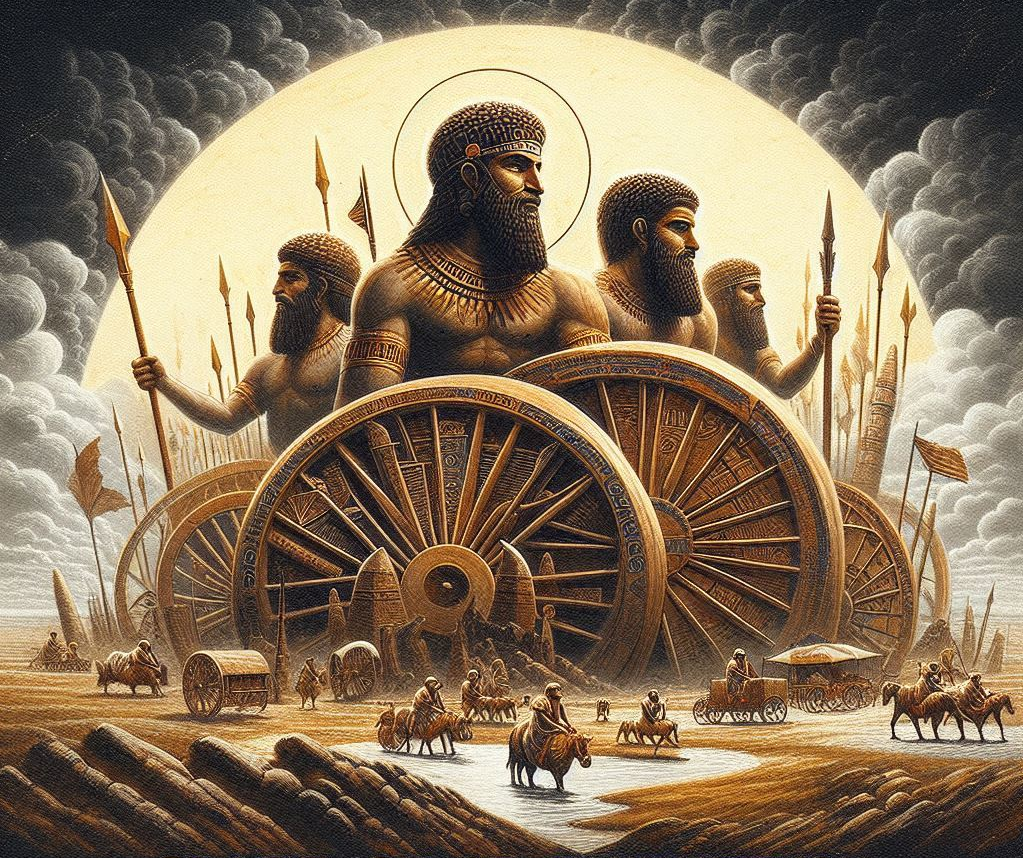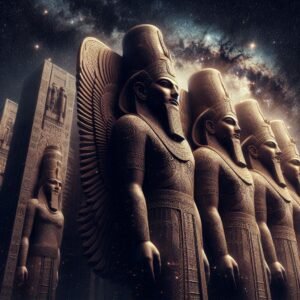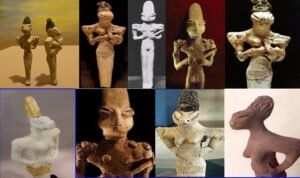
The cradle of civilization, Sumer, was home to the world’s first urban centres, where the wheel of history began to turn. Among the most prominent cities that rose from the fertile Mesopotamian plains were Uruk, Ur, Eridu, Nippur, Lagash, and Kish.
The Sumerian cities were marvels of their time, with advanced infrastructure, including irrigation systems that harnessed the power of the Tigris and Euphrates rivers to support agriculture and sustain large populations. The social structure within these cities was complex, with a ruling class of priests and kings, a class of merchants and artisans, and a vast labor force that toiled in the fields and workshops. The political landscape was dynamic, with city-states often vying for power and influence, leading to alliances and conflicts that shaped the course of history.
Religion permeated every aspect of life in these cities, with each city-state having its patron deity and temple complex that served as the centre of worship and community life. The economy was equally influenced by religious institutions, as temples acted as administrative centres that controlled the distribution of resources and maintained the granaries and storehouses. The Sumerian cities were not just centres of political power but also beacons of culture and learning, with schools that taught scribes and scholars who preserved knowledge in clay tablets.
Uruk, possibly the most famous of these, is often hailed as the first true city in the world, a bustling metropolis that was the heart of Sumerian culture and home to the legendary King Gilgamesh.
Ur, not far behind in its significance, with its magnificent ziggurat dedicated to the moon god Nanna, was a city of immense wealth and religious importance. Its well-planned urban layout, featuring residential neighbourhoods, lavish tombs, and intricate water management systems, reflected a society that was both devout and affluent. The discovery of the Royal Tombs of Ur, with their extraordinary treasures, has provided a glimpse into the city’s opulence and the high status accorded to its rulers.
Eridu, believed to be the earliest city founded by the Sumerians, held a sacred status as the abode of Enki, the god of wisdom and water. It was a cultural melting pot integrating various cultures, with its development centred around the temple to Enki. This indicated a sophisticated blend of religious and practical urban planning, setting a precedent for future cities. Eridu’s status as the southernmost city placed it at the edge of the alluvial river plain, close to the marshes, which may have influenced its more spiritual and tranquil character compared to the vibrant Uruk.
The Citadel of Erbil, a fortified settlement atop an ovoid-shaped tell in the heart of the Kurdistan region of Iraq, is a testament to the longevity of urban human settlements. Its history of continuous habitation stretches back over 7,000 years, making it one of the oldest continuously inhabited sites on Earth. The citadel’s strategic position has seen it witness the ebb and flow of empires and cultures, from the Sumerians to the Assyrians, and from the Mongols to the Ottomans.
Nippur, the religious nucleus of Sumer, was home to the temple of Enlil and served as a spiritual hub for the entire region. Its significance lay not in military might or economic power but in its position as the seat of divine authority, where kings were legitimized, and cosmic order was maintained. The city’s layout and architecture were dominated by religious structures, underscoring its role as a centre of pilgrimage and worship.
Lagash, renowned for its artistic achievements, was a city that celebrated beauty and craftsmanship. Its rulers, such as Gudea, left behind a legacy of statues and inscriptions that speak volumes about the city’s cultural priorities. Lagash’s rivalry with neighbouring city-states like Umma also highlights the political dynamics that were unique to each city’s history and development.
Kish, on the other hand, played a pivotal role in the early dynastic period of Sumerian history. It was one of the first cities to exercise hegemony over the region, and its kings were among the first to be recognized as ‘kings of Sumer’, a title that denoted a level of political authority and influence that was unparalleled at the time.
These cities were interconnected by trade, culture, and a shared cuneiform script, which facilitated the exchange of ideas and goods, weaving a tapestry of urban life that laid the foundations for future civilizations.
The legacy of the Sumerian cities endures to this day, as archaeologists uncover the layers of history buried beneath the sands of Iraq. The artifacts, texts, and architectural remains provide a window into a world that, though long gone, continues to influence our own. The achievements of the Sumerians in law, literature, mathematics, and astronomy are still recognized, and the echoes of their ancient hymns and epics can be heard in the annals of human heritage.
The Sumerian cities, each a jewel in the crown of ancient Mesopotamia, were distinguished by their unique contributions to the tapestry of civilization. Uruk, possibly the most populous city of its time, was a beacon of innovation, credited with the development of cuneiform writing, which underpinned its economic and cultural prosperity. This city was a powerhouse of activity, its strategic location and resource-rich environment fostering a bustling metropolis that was the envy of the ancient world.
Each Sumerian city had its distinct character, shaped by geography, politics, religion, and culture. Uruk’s bustling streets and innovative spirit contrasted with Eridu’s serene spirituality; Nippur’s divine authority differed from Lagash’s artistic soul; Kish’s political prowess was not mirrored in Ur’s economic splendor. These differences were not merely superficial but were embedded in the very foundations of each city, influencing their trajectories through history and leaving behind legacies that continue to fascinate and inform our understanding of the ancient world.
The Sumerian cities were more than just centres of habitation; they were the birthplaces of ideas, technologies, and institutions that have shaped human civilization. Their differences were a testament to the diversity and complexity of human societies, even in the ancient world. As we continue to unearth their secrets, we gain a deeper appreciation for the ingenuity and adaptability of the Sumerians, who laid the groundwork for the urban life we know today. The key differences between these cities, therefore, are not just historical footnotes, but are fundamental to our understanding of the dawn of civilization.
Subscribe to our post updates - Don't miss a thing!!







